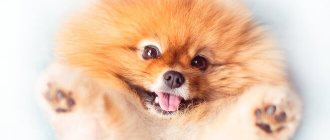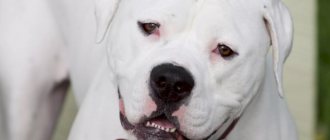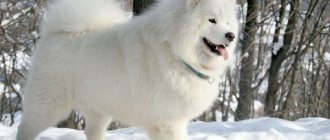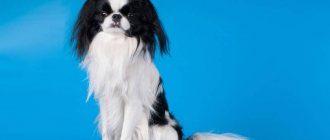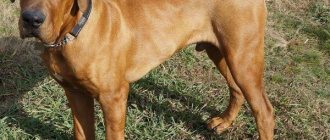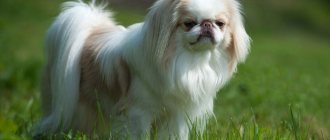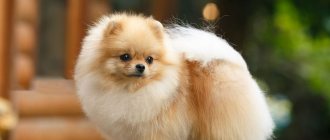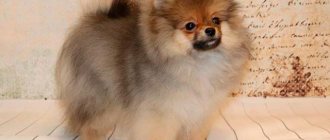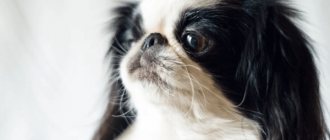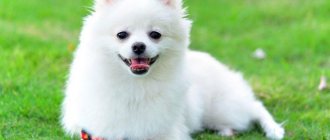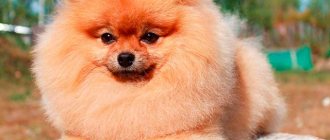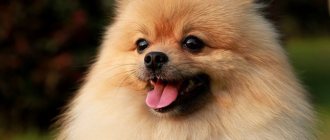Spitz is a large group of breeds, including Northern European, Siberian and Oriental types of dogs. They all have pointed ears and cunning muzzles, thick fur, and a tail thrown over their back. But the Japanese Spitz stands apart.
This is a fairly young breed, work on which began only in the 20th century, and gained recognition in its second half. She immediately became very popular both at home and abroad. What distinguishes these dogs from other representatives of the breed group?
Description of the Japanese Spitz breed
Popularity 105th place among 263 dog breeds
Lifespan:
14-16 years old
Breed group:
Decorative
Height:
28-36 cm
Country of origin:
Japan
Average price:
40-50 thousand rubles
Weight:
5-6 kg
Latest articles Cat health
Ataxia in cats: what it is, how it manifests itself and is treated 01/23/2022 151 0 0
Cat health
Leukemia, or viral leukemia in cats 01/23/2022 140 0 0
Key facts
The appearance of this dog will not leave anyone indifferent. Wool the color of the first snow, black beady eyes, a ring tail - all these characteristics of the Japanese Spitz breed are combined with maximum focus on people, making the dog an excellent friend and full member of the family. The breed also has another name: in its homeland, in the Land of the Rising Sun, it is called Nihon Supitsu.
Unlike most small breeds, these animals do not bark for no reason: they only voice their voices to attract the attention of their owner.
Dogs are very strongly attached to their owner and are ready not to leave him a single step, but at the same time they are not intrusive and will happily lie quietly at his feet. If the dog feels that he has been deprived of attention, he can play pranks so that the person shows interest in him.
The description of the Japanese Spitz breed says that the dogs are distinguished by neatness and cleanliness. And a special protective layer that protects the coat from dirt helps to maintain the purity of the coat.
Animals have good thinking, which allows them to easily learn various commands and tricks, and in their homeland, many of them compete in agility - overcoming a kind of obstacle course for speed and quality. This gives the Spitz great pleasure.
Since pets do not have a hunting instinct, this allows them to coexist perfectly in the same apartment with cats and other contact breeds of dogs, as well as to walk surrounded by their own kind.
These dogs belong to the category of small breeds and are small in size. The height at the withers for a male is 34-36 cm, for a female - 28-32 cm. The weight of a Japanese Spitz ranges from 6-8 kg for males and 5-6 for females.
The average life expectancy of a Japanese Spitz is 14-16 years, meaning these dogs are considered long-lived. It happens that they can live up to 17-18 years.
a brief description of
- Other names: Japanese Spitz, 日本スピッツ, Nihon Supittsu, Nihon Supittsu, silent Asian Spitz, Japanese.
- Height: up to 40 cm.
- Weight: from 7.0 to 10.0 kg.
- Color: exclusively white.
- Coat: fluffy, silky, medium length, soft, dense, short down.
- Life expectancy: up to 13-15 years.
- Advantages of the breed: Very friendly and cheerful animals. Absolutely conflict-free, they are perceived by children as living toys. Dogs practically do not speak, have no smell and are famous for their cleanliness.
- Difficulties: Spitz dogs are extremely wary of strangers, but only severe fear can force the dog to bark. These are monogamous people who find it extremely difficult to cope with separation from their owner. Abandoned animals practically do not survive.
- Price: $2000.
History of the origin of the Japanese Spitz
The country of origin is Japan, as evidenced by the name of the breed itself. It is considered quite young - Japanese specialists received their first representatives approximately in the 30s of the twentieth century. They never told the world what breed formed the basis of these snow-white beauties. Most likely, their closest relatives are German Spitz.
An interesting fact is that until the 40s there was constant selection and changes in the type of animals, which did not make it possible to establish a single standard. That is why it was adopted in 1948 in Japan, but the World Canine Organization agreed to it only in 1964. The American Canine Association flatly refused to classify these dogs as Spitz-type dogs.
In Russia, these dogs first appeared in the circus arena. The famous trainer Nikolai Pavlenko worked with them, and after successful performances, he decided to delve into breeding work, acquiring several high-level breeding sires. Later, one of his dogs became Philip Kirkorov’s pet.
Appearance of a Japanese Spitz
General impressions
These are short animals with snow-white thick fur, a sharp muzzle, stable pointed ears and a small fluffy tail. In the photo, the Japanese Spitz is easy to distinguish from other breeds.
Despite the fact that the Asian handsome man is a Spitz, he has some differences from the standard representatives. This is a dog of a stretched rather than squared format, with a non-standard eye shape and a unique coat color.
Head
Representatives of this breed have a medium-sized, round head. The muzzle is pointed and wedge-shaped. The transition is clearly pronounced. Classic scissor bite, 6x6.
The nose is small, black, sometimes with a purple tint. The lips close tightly. The eyes are almond-shaped, set deep and slightly slanted. The black outline of the eyes is clearly drawn. The ears are small and set high.
Neck
Due to the thickness of the coat, it is slightly expressed. Quite strong, curved, not long.
Torso
The most important proportion in the dimensions of Japanese Spitz is the height to length ratio of 10:11. The format is elongated, the withers are slightly pronounced, the back line is straight. The lumbar region is dome-shaped. The chest is wide, round, deep set. The lowest point of the chest should be at the level of the dog's elbows. The belly is lean.
Forelegs
The shoulders have a good angle of inclination, the forearms are straight, parallel to each other, directly perpendicular to the surface. Elbows are pressed to the body. The pasterns are small but strong, the pads and claws are black.
Hind limbs
The hind legs are more powerful, strong, and the muscles are well defined. The hock joints are parallel to each other and at a relative angle.
Tail
It has the shape of a ring with one curl, covered with thick hair. A double curl is considered a critical disqualifying fault.
Movements
The movements are fast, active, the step is sweeping, the front legs do not cross the midline when running. The tops of the croup and withers should be at the same level. During active movements, the dog does not rake the soil with its paws and does not deviate from the straight path of movement.
Wool
It is represented by two layers - a thick, densely padded soft undercoat and a coarser and harsher outer coat. The extended part requires regular careful maintenance using special products. There are areas with short hair: pasterns, metatarsals, muzzle, ears, front part of the forearms.
Color
The only acceptable color of the Japanese Spitz according to the FCI breed standard: white, without any other inclusions or shades.
Size
The height of a male Japanese Spitz at the withers should be no lower than 32 cm and not exceed 36 cm. Optimal height is 33-34 cm. The female should be no lower than 28 cm, but not exceed 34 cm. The weight of male dogs should not fall below 6 kg , females – below 5 kg.
Any deviation from the official breed standard may reduce the show score. Disqualifying defects do not give the dog the right to participate in national and foreign exhibitions. This applies to the size of the Japanese Spitz and other parameters.
Breed defects
Drop ears are a breed defect.
Any difference from the standard is considered a breed defect.
For example:
- snack or undershot;
- double curled tail;
- noisy and cowardly dogs.
Vices for disqualification include:
- drooping ears;
- tail that does not lie on the back.
Boys are checked for the presence of two well-developed testes.
Character of the Japanese Spitz
The question “Who is this breed suitable for” can be safely answered – everyone. Of course, only if you don't plan to take your dog hunting with you. They are excellent companions for both adults and children.
The character of the Japanese Spitz is characterized by great friendliness, activity, curiosity and charisma. The breed is perfect for living in both urban and suburban conditions in the house.
The dog loves all family members without exception, giving his little heart to children, knowing that it is with them that he can fool around and throw out the accumulated energy in noisy games. At first he is wary of strangers and guests, but as soon as he makes sure that they do not cause harm, he begins to get acquainted with interest.
Despite its size, the Spitz has good protective qualities, communicating with its voice that something is bothering it. At the same time, representatives of this species cannot be called empty-mouthed dogs that break into loud barking at the slightest rustle.
He gets along well with cats and other non-aggressive dogs, feels great when walking in the company of other dogs, and starts a pack of games. These animals are highly active, so you need to walk them at least twice a day. In winter, Spitz dogs do not freeze outside, which makes it possible not to reduce the number of walks during the cold season.
Spitz dogs have a stable psyche and a good mind. They are easy to train, instantly learn commands, and perform various tricks. It is worth noting that all this gives dogs great pleasure.
These are very sociable dogs that do not like prolonged loneliness. Missing its owner, not knowing what to do with itself, the pet can act out, knowing that they will pay attention to it and next time they will not want to leave it alone for a long time.
The character of an adult is no different from the behavior of a baby.
Socialization
The friendly disposition of the “Japanese” makes it possible to keep him in a family where there are children or are just planning to have a baby. A dog of this breed is not prone to jealousy, so the little owner will become his best friend in the future.
The “Japanese” always gets along with other pets. Cats and dogs living in the same territory will not constitute competition. After all, the non-conflict nature of the Japanese Spitz allows him to adapt to any conditions.
But, like any breed, the Asian Spitz needs early socialization. Communication with other four-legged animals, getting to know noisy streets and people are necessary, especially if you are planning a future exhibition. After all, a Japanese Spitz sitting at home all the time will not be able to behave adequately in an unfamiliar environment.
Education and training
Before you begin raising and training a Japanese Spitz, you need to establish close emotional contact with him. You can start learning the first exercises a few weeks after the Spitz has moved to a new home.
It’s worth starting with simple basic commands: “Sit”, “Lie down”, “Voice”, “Give me a paw”. After the baby has received the latest vaccinations and is in quarantine, you can begin to perform commands such as “Near” and “Come” during walks. Knowing them is mandatory for any dog, because they ensure the safety of the pet.
Correct execution of the exercise should be reinforced with loud praise and a small piece of your favorite treat - Spitz love the owner’s display of emotions.
If you have some free time, try learning various tricks with your baby - examples can be found on the Internet. Don't be afraid that you will overload your dog - Japanese Spitz are surprisingly active, agile and hardworking dogs.
If you have a child in your family, you can make a move and get them both interested, for example, by inviting them to try agility or freestyle. Asian beauties move beautifully and quickly, leaving many competitors behind them on agility courses.
As for toilet training, it is worth remembering that despite its size, the Spitz is a full-fledged dog that wants and can move a lot. Therefore, as soon as the street is mastered, you should forget about diapers and trays and enjoy walks together, regardless of whether it is winter, spring, summer or autumn outside the window.
Pets practically do not chew furniture and shoes, doing this in exceptional cases - demanding their share of attention from the owner.
There are no detailed instructions on how to raise a dog of this breed - all Spitz are individual, and they need to be raised taking into account their character and behavioral characteristics.
Learning ability
Even a beginner can train a Japanese Spitz - the dog is attentive and reacts to the slightest movements of the owner. The Spitz quickly gets bored with traditional commands, but he enjoys mastering tricks and agility exercises, delighting the owner with his incredible artistry. The dog loves to be the center of attention.
Most Spitz dogs are food eaters, which means they need to be trained with treats and positive reinforcement. With the right approach, a dog can master a complex exercise in just 5 repetitions.
In training, the owner must show firmness and consistency, praise only for the correct execution of the command, otherwise the Japanese Spitz will begin to cheat. Cruelty is unacceptable - the dog will quickly become irritable and cowardly.
To participate in exhibitions, Spitz puppies are taught the correct stance, showing their teeth and ears without aggression. Then they practice the correct movements in the ring. Then they begin the general obedience course.
Key commands of the general course:
- "Sit"
- "Lie"
- "Stand"
- "Near"
- "To me"
Japanese Spitz photo, breed description, character, reviews, care
Health and disease of the Japanese Spitz
Possible diseases
Representatives of this breed are distinguished by excellent health, which is rare for small dogs. The average life expectancy is 12-14 years, some individuals live up to 16-17 years.
These dogs have virtually no hereditary diseases, but their weak point is their eyes. They are characterized by high photosensitivity, which in some cases can lead to disruption of the visual apparatus and the development of a number of diseases, such as cataracts or glaucoma.
Some representatives of the breed suffer from epileptic seizures. The first attacks are diagnosed before the age of 2 years; if they were not detected before this period, the likelihood of their occurrence in the future tends to zero. If they have been diagnosed, such an animal is not allowed for breeding.
Digestive problems are common to all small breeds, so you should feed your dog low-fat food. It is the presence of heavy food in the diet that causes gastrointestinal disorders in Spitz dogs. But at the same time, Asians are not at all prone to allergic reactions, which is rare among small white dogs.
Reproductive health
Animals older than 12 months are allowed for breeding. The optimal age for the first mating in a male is 10-12 months, in a female - the second or third heat (depending on the interval between them).
Estrus occurs twice a year and lasts approximately 24-28 days. With this cycle, mating is carried out on the 11th day and control – on the 13th day. Males can be used for breeding no more than 8 times a year.
In most cases, childbirth is easy and without complications. The bitch can cope on her own, there is no need to resort to the help of a veterinarian. During the first pregnancy, 1-2 puppies appear in the litter, with subsequent ones a little more, 2-4 puppies. Females have excellent maternal instincts, providing their offspring with warmth and food.
If the dog is completely healthy, sterilization is not recommended. If there are medical indications, the operation is performed no earlier than a month after the end of estrus or the cessation of feeding the puppies.
Features of feeding and diet
There are two feeding options - dry food or natural food. It is impossible to say which is better. It is necessary to take into account the digestive characteristics and taste preferences of your pet. The diet should not contain anything floury, fatty, sweet, smoked, spicy, salty, as well as products containing dyes and flavors.
If you decide to feed your puppy “natural” food, then you should use lean varieties of meat, poultry and fish, avoid bones, but pamper them with cartilage and joints for chewing. The diet must include fruits and vegetables, cottage cheese and a chicken egg, if there is no allergy to it.
You also need to remember about vitamins - your veterinarian will recommend them. There are currently a large number of dietary supplements for animals on the market, among which you can choose special multivitamins for babies.
In order to calculate the daily amount of natural food, you can use the standard formula: up to 6 months. food should make up 6–7% of the dog’s weight, older than 6 months. - 3–3.5%. When feeding “dry”, it is not difficult to find out the norm: it is usually indicated on the package.
If you want to raise a dry dog, then the breeder will give you an answer to the question of what food to feed the puppy. He will tell you which food is best suited for this breed, how many times to feed a one-month-old puppy, how the diet changes as the dog ages, and whether it is possible to give the baby kefir and cottage cheese. In most cases, preference is given to premium, super-premium and holistic food. Among them, you need to choose those that are made specifically for small breeds.
Care and maintenance
Regular care and maintenance of the Japanese Spitz includes brushing, trimming nails, and wiping the area around the eyes.
Japanese Spitz have thick fur. To prevent it from getting tangled, you need to comb it regularly with a special massage brush. During molting, it is recommended to use a special slicker or furminator. It is also necessary to carefully monitor the cleanliness and dryness of the skin, since dermatitis and weeping eczema instantly develop on a damp area covered with so much fur.
Frequent washing is not recommended. You should bathe your pet as soon as it gets dirty, using a special shampoo for white dogs and conditioner for thick, fluffy coats. Show dogs undergo cutting and grooming procedures.
Nails must be trimmed with a nail clipper at least once a month, and for dogs attending exhibitions - as they grow.
On sunny summer days, dogs who spend a lot of time outdoors have no problem catching ear mites. Therefore, every day it is necessary to carefully examine your ears for increased secretion of earwax. If you notice dark yellow discharge and the dog is clearly worried about the condition of its ears, you should visit a veterinarian who will take a scraping.
Many owners are concerned about how to care for their pet's teeth. To prevent the formation of tartar, you can use special products in the form of treats or special drops that should be added to a bowl of water daily to cleanse the mouth of plaque and unpleasant odor.
In damp and dirty weather, it is recommended to wear special overalls on your Spitz in order to minimize staining of the pet’s fur.
Tips for choosing a puppy
First of all, determine the purpose for which you are purchasing a Spitz. If you and your family need a little furry friend, you can choose a beautiful, healthy pet-class puppy without going into the breed’s anatomical features. If you plan to conquer the rings of all-Russian and international exhibitions, you need to approach your choice more carefully.
In any case, regardless of your goal, the chosen baby should be healthy, active, and curious. He should approach a stranger with interest, showing active interest in him.
Be sure to ask the breeder to show you the bitch, the mother of the litter, and evaluate the visual condition of the dog: does she have any signs of any diseases. Many dog breeds shed heavily during pregnancy and the first months after it, this should not bother you.
Animals must show no signs of umbilical or inguinal hernia and must have healthy, clean eyes, a scissor bite and 6x6 teeth.
Most potential owners are concerned about the question of how to choose a purebred baby. Japanese Spitz puppies should be purchased from a breeding nursery with a full package of documents - a puppy card, which is then exchanged for a pedigree in the Russian Canine Federation, and a veterinary passport with vaccination marks. Some breeders fill out a purchase agreement.
By purchasing a dog from a professional breeder, you receive a guarantee that the dog is a purebred representative of this breed, which means it fully complies with the standards and is allowed for exhibitions and breeding (if it is not a pet class).
Historical reference
So, the Japanese Spitz dog was created according to “orders from above.” I would like to believe that under pressure, the breeders were motivated by personal goals. The dwarf white fluffy was supposed to play the role of anti-stress for families who survived the war and were living through the economic crisis.
The first attempt to breed your own Spitz took place before the war, in 1920. Lacking native stock, the Japanese exported dogs from other countries and tried to create something new by interbreeding. They even dared to demonstrate the “raw” breed at an exhibition in Tokyo. The debut was successful, but the breed required serious improvement.
To continue the work, the blood of already formed German Spitz dogs was taken as the “base”; almost all miniature representatives of the breed group known in those years (1925–1936) acted as “correctors”. The “first breakthrough” was successful; the breakthrough took place after the introduction of the American (Eskimo) Spitz into breeding work. This does not mean that the blood of the American variety “solved” everything; most likely, it served as the finishing touch.
This is interesting! Japanese Spitz are characterized by an “Eskimo smile”. This trait makes the dog similar to the Samoyed Laika, but apart from the external similarity, there are no “tricks”; the breeds are not related.
The last military conflict of World War II that took place on Japanese territory lasted from 08/09/1945 to 09/02/1945. As you know, the confrontation ended with the surrender of Japan and the collapse of its economy. Fortunately, the stud books of the Japanese Spitz survived, and the livestock did not need to be revived. Having shaken off their torpor, by 1948, Japanese experts officially issued a breed standard, which automatically recognized it. The board did its best to help switch the population to a positive direction, and the white fluffy one came in very handy.
Thanks to government propaganda (including), by 1950, the Japanese Spitz dog breed was at the peak of its glory. Tailed animals began to be actively imported and conquer the world. FCI (Canine Federation Internationale) experts “accepted” the newcomers and the previously written standard of the Japanese Spitz. True, the event took place only 14 years later, when the number of dogs that had spread across all continents could no longer be ignored. By 1977, the English cynologists (UK) also gave in, recognizing the newcomers with their international description of the breed. Only the AKC (American Kennel Club) dog handlers remained adamant, since the Japanese guest was a gallant competitor to the American Spitz.
